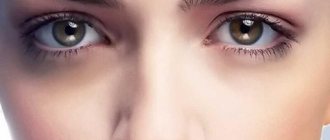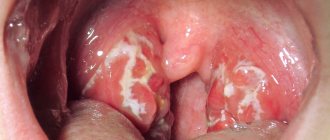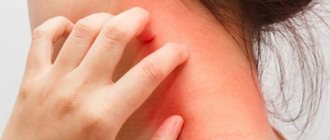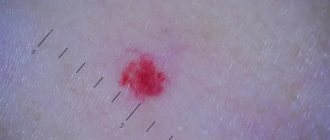Some people believe that bags under the eyes are only a cosmetic problem, but there are many reasons for swelling on the face.
To understand why bags under the eyes occur, you need to dwell a little on the anatomical features of the eye socket. The eyeball itself is a fragile organ that needs constant protection. In this regard, the eyes are surrounded on all sides by a layer of adipose tissue, which protects it and has a shock-absorbing property. This periorbital tissue is separated from the skin of the eyelids only by a thin layer of connective tissue. This membrane prevents the contents of the orbit from penetrating beyond its boundaries.
Causes of bags under the eyes
Bags under the eyes appear when the elasticity of the membrane decreases, as a result of which its strength decreases, and the contents of the orbit bulge with the formation of a hernial sac.
Not long ago, another theory was proven, which connects the appearance of bags under the eyes with an increase in the amount of fiber itself. Because of this, it also protrudes beyond the orbit. If this fiber did not accumulate liquid, it would not be so noticeable.
Due to edema, the volume of fat around the eye increases significantly, which leads to the formation of a hernial protrusion. Causes of edema include excessive salt consumption, significant insolation (the skin accumulates moisture, protecting itself from drying out), and eye fatigue.
If bags under the eyes appear due to fluid retention, then by evening they usually become less noticeable. This is due to the fact that lymphatic drainage and blood circulation are activated during wakefulness. As a result, excess fluid is removed from the upper parts of the body.
If the size of the bags under the eyes remains unchanged during the day, then the cause is the growth of fiber. Often this condition is hereditary. At the same time, the skin in this area acquires a darker shade.
In older patients, the elasticity of the skin is also reduced, and the amount of fiber around the eye gradually increases. In addition, patients of this age have more risk factors leading to fluid retention.
Swelling of the eyelid
The eyelids are folds of skin around the eyes, consisting of many organs, each of which plays an important role. The muscles help a person blink, the conjunctiva helps to moisturize the eyeball, and the meibomian glands retain moisture. Together they form a complex system, the main purpose of which is to protect the eyes from drying out, dirt, bright light and other negative environmental factors. Inflammation of one of the organs leads to the development of diseases, the main symptom of which is swelling of the eyelid.
Symptoms
Characteristic signs of developing pathology include:
- swelling of the area around the eyes;
- increased temperature (symptoms of barley, conjunctivitis, furunculosis);
- pallor of the skin – with a non-inflammatory nature of the disease;
- characteristic enlargement of lymph nodes - during the inflammatory process.
What complications can arise from eyelid swelling?
- When excessive internal pressure occurs, glaucoma occurs.
- Decreased visual acuity, complete blindness.
- Operable and inoperable cancer.
Description of the disease
Edema of the eyelid is a pathological accumulation of fluid in the area of loose connective tissue. The process results in visible swelling around the eyes.
Swelling in this area forms quite easily. This is due to the fact that the subcutaneous layer of fiber and muscles are poorly developed, and there are many blood vessels. Swelling of the area around the eyes is a common phenomenon that causes a lot of inconvenience. In addition, this is an alarming sign indicating a malfunction that has occurred in the body. Many people first of all think about the aesthetic component. But if a cosmetologist can get rid of the external manifestations of the disease, he will not solve internal problems.
Swelling is a symptom of many diseases, as well as a sign of an unhealthy lifestyle. Thus, swelling can occur due to a violation of the drinking regime or diet, alcohol abuse, or addiction to salty foods. Such swelling is physiological in nature, disappears within 24 hours and does not require medical intervention.
If the swelling is systematic and does not go away on its own, it cannot be considered as a cosmetic problem - you need to contact an ophthalmologist.
Classification of eyelid edema
Depending on the history, there are several types of edema of the paraorbital region:
- Inflammatory. The cause is bacterial damage. As a result of the negative impact, suppuration begins. Pus accumulates in the paraorbital area, the eyelids swell. Externally, the pathology is expressed in the form of hyperemia of the eyelids, a noticeable thickening at the site of the disease.
- Non-inflammatory. Unlike the inflammatory variety, this process rarely manifests itself visually. The main symptoms are pale skin and swelling in the morning. It usually appears on the lower eyelids and indicates a malfunction of some internal organs - liver, kidneys, thyroid gland. It can also occur due to incorrect head position during sleep.
- Allergic. In case of contact with an irritant, it begins to develop rapidly. After eating a food that causes an allergy, swelling appears after a couple of hours. The most aggressive form of the reaction is Quincke's edema, in which not only the eyelids, but also the tissues of the head, neck, and larynx swell. This leads to difficulty breathing and therefore requires immediate medical attention.
- Traumatic. In this case, it is not necessary to injure the area around the eyes: the eyelid swells when the soft tissues and muscles of the face are damaged. This could be a bruise, surgery, consequences of plastic surgery, microtrauma caused by wearing contact lenses.
- Reactive. The cause of its appearance is an inflammatory process near the paranasal sinuses.
Causes of edema
The main causes of paraorbital swelling, which causes discomfort and spoils external aesthetics, can be divided into two categories - pathological and non-pathological.
Non-pathological causes include:
- Fatigue caused by increased eye strain, prolonged sitting at the computer, and lack of sleep.
- Diet violation. For example, the abuse of pickles, which retain water in the body.
- Drinking large amounts of liquid.
- Alcohol abuse. Alcohol displaces fluid from the body, which leads to a constant feeling of thirst. An unpleasant “bonus” is swelling of the paraorbital area.
- Incorrect head position during sleep. If you sleep on a low pillow or without one at all, you can provoke an abundant flow of blood to the head, which causes bilateral swelling. When sleeping on one side, fluid accumulates, resulting in unilateral swelling.
- Poor quality cosmetics, lack of habit of removing makeup.
- Eyelash extensions, tattooing, anti-aging procedures.
- Injuries. A bruise on the bridge of the nose provokes bilateral swelling. Trauma to the eye area is the cause of unilateral swelling. Various maxillofacial and plastic surgeries also lead to similar consequences.
- Predisposition. People with thin skin often experience swelling around the eyes in the morning after drinking an extra glass of water in the evening. Edema can also appear due to excessive physical exertion.
- Age. Over time, the tissue and muscles of the eyelids weaken, fat sag, and large amounts of fluid accumulate, causing “bags” to form.
If we talk about pathological edema of the paraorbital region, they can be provoked by both eye and general diseases:
- Barley. Characterized by pain, hardness, and swelling. The swelling gradually increases, the skin turns red, but the site of inflammation is localized. After opening the abscess, the swelling subsides.
- Conjunctivitis. The causes of pathology are often streptococci and staphylococci. In severe cases of the disease, swelling of the eyelids gradually begins to develop.
- Blepharoconjunctivitis. Symptoms: inflammation of the mucous membrane of the eye and eyelids.
- Trachoma. Pathology caused by chlamydia.
- Chalazion. A disease involving the edges of the eyelid, meibomian gland, cartilage. In some cases it is chronic.
- Blepharitis. Inflammation of the edge of the eyelids, accompanied by hyperemia, peeling, swelling, itching, and loss of eyelashes. The cause of the pathology is an allergic reaction to external irritants.
- Ophthalmoherpes. Symptoms: swelling around the eye, pain, itching, redness of the conjunctiva.
- Benign and malignant neoplasms in the eye area.
- Tuberculosis of the eye.
- Graves' disease. Caused by an increased amount of hormones produced by the thyroid gland. It manifests itself as protrusion of the eyeball, swelling of the periorbital region.
- Demodecosis. Damage by the parasite, accompanied by loss of eyelashes, discharge of pus, redness, itching, swelling.
- Fatty hernia, sinusitis. Often provoke swelling of the lower eyelid.
- Diseases from the ENT system.
- Kidney diseases. Characterized by bilateral, pale, soft-to-touch swelling.
- Pathologies of the cardiovascular system.
- Changes in hormonal levels. Sometimes small swellings are observed on certain days of the menstrual cycle. Swelling can also occur during pregnancy.
Not all pathologies indicated in the list have a real threat to human health and life.
Doctors are especially monitoring people with diseases of the cardiovascular system, kidneys, and endocrine glands.
Prevention
To prevent swelling of the paraorbital area, experts recommend adhering to certain rules:
- Do not drink large amounts of liquid. In the evening, you should refrain from salty foods, as they provoke a feeling of thirst. Before going to bed, just drink a glass of herbal infusion and warm milk. This will quench your thirst and help avoid morning puffiness. Fans of soda, strong tea, and coffee should limit the amount of these drinks.
- Maintain personal hygiene. The eyelids need to be cleaned daily - morning and evening before going to bed. This is especially true for women who use decorative cosmetics. It is also important that each household member has a personal towel that needs to be changed regularly.
- Using quality products. Facial care products and cosmetics should be purchased from trusted manufacturers - this will help avoid purchasing low-quality or counterfeit products. You should also consult with a specialist before the tattoo procedure.
- Compliance with safety regulations. Some professions involve processes and tools that can damage the mucous membranes and skin around the eyes. To avoid this and maintain your health, you must wear special glasses while working.
- Eye protection in the summer. Direct ultraviolet rays have a negative effect on the eyes in particular and the body in general. To protect the delicate mucous membrane of the sun, you need to wear glasses, use an umbrella or a hat with a wide brim.
- Maintaining distance when communicating with people. If the interlocutor is coughing, sneezing, or has visual signs of eye diseases, such as stye, it is better to postpone communication until he recovers.
- Regular cleaning of premises. Doctors note that the number of patients with allergies to dust, mold and other household contaminants is growing every year. This is why it is so important to carry out thorough and regular cleaning of premises. It is also worth going through old things and getting rid of those that are no longer useful, because they are an excellent accumulator of dust in a living environment.
- Pet care. Animal fur is a powerful allergen to which a large number of people are sensitive. To prevent your furry pet from becoming the cause of illness, you must regularly vacuum carpets, rugs, treat upholstered furniture and textiles, and comb your pets thoroughly, especially during seasonal molting.
If paraorbital edema has already appeared or often “pleases” you in the morning, you need to contact a specialist who will help you find out the cause, adjust your daily routine, diet and drinking regimen.
How to treat eyelid swelling
- If the cause of swelling is a bruise, the eyelid usually immediately begins to increase in volume. In this case, it is necessary to wash your hands with unscented soap, since scented options can cause an allergic reaction. Then treat the injury site with an antiseptic and apply a cold compress - it will help stop the growth of swelling. Then cover the affected area with a sterile cloth and go to the emergency room.
- Cold compresses or ice cubes. Moreover, these can be cubes from herbal decoctions, such as calendula, mint or parsley. If necessary, the pieces are removed from the mold, wrapped in gauze, and carefully wiped over the eyelids.
- Tea lotions. It is especially convenient to use tea in bags, which must first be brewed and cooled to room temperature.
- Eye drops. In this case, it is important to consider the cause of the tumor. So, Oftalmoferon will help in case of eye damage from viruses. Tetracycline is indispensable when swelling is caused by bacteria.
- Decongestants. They are usually prescribed in case of blockage of the sebaceous gland. In a hospital setting, Tavegil will help cope with extensive swelling.
- Analgesics. The inflammatory process is often accompanied by painful sensations. To alleviate the condition, you need to take Analgin.
- Ointments. Hydrocortisone ointment has a pronounced antibacterial effect and helps eliminate swelling.
- Absorbents. You can use activated carbon, which will remove the substance that causes the swelling from the body.
- Antihistamines. You should take allergy medications only after seeing a doctor. Suprastin, Claritin, Zodak, Diazolin and others are usually prescribed.
- Use of liquid nitrogen. In the absence of metastases, the substance can help destroy the focus of a malignant neoplasm.
- Operation. Surgery will allow you to remove the cancer with excision of a small area of tissue surrounding the tumor. If further tests are within normal limits, the patient undergoes plastic surgery to correct the defect.
- Application of drops. Drugs from the vasoconstrictor group are used. Vizin and Octilia have proven themselves especially well.
In the case of malignant neoplasms in the later stages, the prognosis does not look very optimistic. If a small area is affected, all tissue from the area is removed during surgery. If manipulation is not practical, the patient is prescribed radiation and chemotherapy.
Lifestyle
You can help avoid swelling by following simple recommendations:
- Do not come into contact with substances that cause an allergic reaction.
- If itching occurs, it is important not to scratch it.
- Regularly visit doctors of various specialties.
- Rejection of bad habits.
- Controlling the amount of liquid you drink.
When contacting our center, the patient can be sure that he will receive the most modern, effective treatment, selected taking into account the individual characteristics of the patient’s body.
Timely consultation with a doctor, competent therapy, a healthy lifestyle, and following the doctor’s instructions are the key to a positive result with minimal financial costs.
Author
Danilova Elena Fedorovna
ophthalmologist
17 years of experience
+7
Diseases that cause bags under the eyes
Kidney failure
The first thing to rule out in a patient with bags under the eyes is kidney disease. In this case, swelling increases rapidly (within several hours). Other symptoms are fever, weakness, lower back pain, changes in the nature of urine (transparency, quantity, color). All these signs characterize inflammatory kidney diseases that occur with cystitis, sore throat, and colds.
The loss of albumin in the urine also leads to edema. This protein is dissolved in the blood and holds fluid in the bloodstream. Normally, albumin does not penetrate the membrane of the renal tubules, but with pathology, this barrier becomes more permeable, and large protein molecules enter the urine. The disease is diagnosed based on urine analysis and kidney ultrasound. This is often accompanied by arterial hypertension.
Sinusitis
With inflammation of the paranasal sinuses, swelling of the tissue may also develop. These sinuses are located in the bone structures of the skull and are connected to the nasal cavity. At the same time, other symptoms of the disease appear: runny nose, pain in the projection of the sinuses, headache, fever. The cause of inflammation can be a viral or bacterial infection. To make a diagnosis, it is necessary not only to examine the patient, but also to perform an x-ray examination. In this case, sinusitis, sinusitis or sinusitis may be detected.
Allergy
Allergic diseases are also often accompanied by swelling of the eyes. With conjunctivitis, allergies are often caused by various substances that lead to redness of the mucous membrane and swelling of the eye. Itching and irritation also occur. Many patients have a seasonal nature of these changes, which is associated with flowering plants. It is important to end contact with the allergen as soon as possible and contact a specialist for treatment.
Conjunctivitis
Inflammation of the conjunctiva can be associated not only with an allergic reaction, but also with infection or chemical irritation. Typically, bacteria enter the surface of the conjunctiva due to poor hygiene, through contaminated objects and hands. Irritation of the mucous membrane of the eye is also caused by environmental factors (smoke, dust). To determine the cause of inflammation, you need to visit an ophthalmologist.
Quincke's edema
Acute edema of an allergic nature (Quincke's edema) is classified as a separate group, since this condition is quite dangerous. This reaction develops rapidly and often threatens the patient’s life. Symptoms of Quincke's edema are a dry cough, swelling of the neck and face, shortness of breath and difficulty breathing that occur after contact with the suspected allergen. If such symptoms appear, you should immediately call an ambulance, since the swelling extends not only to the subcutaneous tissue, but also to the mucous membranes and fascia.
At the same time, substances are released into the blood that significantly increase the permeability of the vessel wall for protein and liquid. Due to swelling of the bronchial wall, the respiratory tract narrows significantly, which makes breathing difficult. Quincke's edema is often caused by an insect bite (wasp, bee).
ARVI
Acute viral infections affecting the respiratory tract can also cause swelling of the periorbital tissue and conjunctiva. In this case, the characteristic symptoms of ARVI are runny nose, conjunctivitis, fever, and sore throat. Most often, the eyes are affected by adenovirus infection.
Hypothyroidism is associated with a deficiency of thyroid hormones in the patient's blood. Symptoms of the disease are swelling of the hands, face, tissue of internal organs, slowing of metabolic processes, which leads to obesity, decreased attention and memory, bradycardia, dry skin and hair. In advanced cases, myxedema (swelling of the subcutaneous tissue and skin) forms. To confirm the diagnosis, you need to perform an ultrasound of the thyroid gland and an analysis of thyroid hormones. Treatment is carried out through replacement therapy.
Diagnosis and treatment of red spots
Most often, spots around the eyes appear suddenly - at first they may be pink, but then they actively progress and become redder. You should consult a doctor immediately if you notice pale spots - do not wait until they become pronounced.
Typically, for this symptom, doctors prescribe a general blood test, an ultrasound of internal organs, an allergic reaction test, and a skin scraping to assess the condition of the epidermis. If necessary, examinations by a dermatologist, endocrinologist, neurologist or gastroenterologist can be prescribed.
At Dr. Belikova's Eye Clinic you will receive high-quality, fast and effective medical care. We employ ophthalmologists with extensive experience in the diagnosis and treatment of diseases of the visual organs of varying degrees of complexity.
Heart failure
In the case when the appearance of bags under the eyes is accompanied by shortness of breath, pain in the heart, and peripheral edema, the cause may lie in heart failure. If the functioning of the heart is disrupted, then the entire body suffers from a lack of nutrients and oxygen. First, swelling forms in the legs, and then spreads to other tissues and organs. Facial swelling is a sign of anasarca, which threatens the patient's life and is an extreme manifestation of heart failure. To confirm the diagnosis, you need to perform an ultrasound of the heart, an ECG and a number of other studies.
In men and women, the incidence of swelling under the eyes is approximately the same, but in children this symptom rarely occurs, therefore, in some cases it goes unnoticed.
Treatment of skin diseases around the eyelids
If suspicious inflammation in the eyelid area, redness, or pain appears, you should consult an ophthalmologist. After the examination, the doctor will make an accurate diagnosis and explain what to do for eyelid swelling and other symptoms, prescribe adequate treatment, and recommend preventive measures. This can be a massage of the eyelids with rinsing of the lacrimal ducts, opening of formations on the eyelid, the use of ointments and medications.
Ophthalmologists at the MedicCity clinic will quickly find the cause of your eye disease.
We use high-precision diagnostic equipment and the latest methods for treating various ophthalmological diseases!
Come to us, we will take care of your vision!
Bags under the eyes of a child
Bags under the eyes in children are not always associated with a disease. Normally, this can occur with prolonged crying or screaming of the baby, with excessive consumption of water or salt, after sleep.
If the swelling under the eyes of a child is physiological in nature, then it goes away on its own within a few hours. Also, bags under the eyes can become a symptom of various diseases. In the following cases, you need to show the child to the pediatrician:
- The appearance of the bags was sudden. In this case, there is redness of the eyes, increased tearing, runny nose, and anxiety. These signs indicate an allergy, including angioedema, which requires immediate intervention.
- In addition to bags under the eyes, there is fever, headache or lower back pain, and problems with urination. These symptoms appear with kidney disease.
- If a small child not only has bags under his eyes, but also bulging fontanelles and anxiety, this indicates intracranial hypertension.
- Bags under the eyes persist for a long time and do not decrease in the evening.
Types of allergic reaction
Exposure to allergens can cause different types of body responses. Depending on the causes, mechanisms, and manifestations, allergies in the eye area are divided into:
- Vernal keratoconjunctivitis. A chronic seasonal disease that is typical for children and adolescents during the period of hormonal changes in the body.
- Hay fever. Seasonal response of the body to irritation by plant pollen. As a rule, it occurs annually during the flowering period of a certain plant. Any pollen can cause a problem, but most often it is ragweed and birch3.
- Chronic form. In the case of constant exposure to an allergen or a severe reaction, an immune response occurs that worries for weeks, then passes and occurs again.
- Acute reaction. Periodic allergies that occur specifically at the moment of exposure to an allergen. After it disappears, the reaction quickly passes and does not occur until contact occurs again.
Treatment for bags under the eyes
At home, eye bags can be dealt with only with physiological swelling of the fiber. To do this, normalize the daily routine, reduce the amount of salt and water consumed, give up bad habits, and consume vitamins, minerals, and fiber.
Some cosmetics also help relieve puffy eyes. These include cold or hot compresses with herbal infusion (fennel, tea, sage, dill, chamomile). Self-massage of the face and exercises that strengthen muscles also help. The most radical treatment method is blepharoplasty, in which the doctor surgically removes hernial protrusions.
However, no medications should be used without a doctor’s recommendation, as this can lead to irreversible and very serious consequences. For example, the use of diuretics leads to an imbalance of microelements (potassium, magnesium, sodium), which makes it difficult for the heart to function.
Hernial protrusion of the periocular tissue is not accompanied by pain, but it significantly worsens the appearance. However, if the cause of this condition is related to a disease in the body, then you need to consult a doctor. Late diagnosis often has a negative impact on the patient’s health.
Photos "before and after"
SMAS face and neck lift, blepharoplasty of the upper and lower eyelids. Surgeon: Iskornev A.A.
Done by Iskornev A.A.
Done by Melnikov D.V.
Causes of blepharitis
Why does this inflammation occur? Often this is a consequence of age-related changes, the presence in patients of chronic diseases of the gastrointestinal tract, seborrheic dermatitis, rosacea, diabetes mellitus, Sjogren's syndrome, rheumatoid arthritis, psoriasis, atopic dermatitis, rosacea and hormonal changes. Systemic intake of retinoic acid drugs (for the treatment of acne), hormone replacement therapy used by women during menopause, antihistamines, and antidepressants also contributes to the development of blepharitis. Violation of local immunity, the presence of immunodeficiency states and frequent use of cosmetics (especially high-density foundation) are provoking factors for this pathology.
Also, according to Russian and foreign publications, a common cause of inflammation is uncorrected or incorrectly corrected refractive errors (farsightedness, astigmatism, less often myopia). Therefore, when correcting vision, it is very important to find a competent specialist who selects glasses according to clinical standards.










